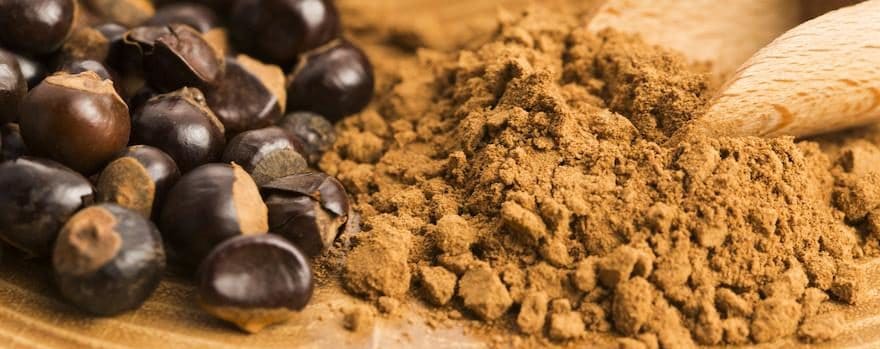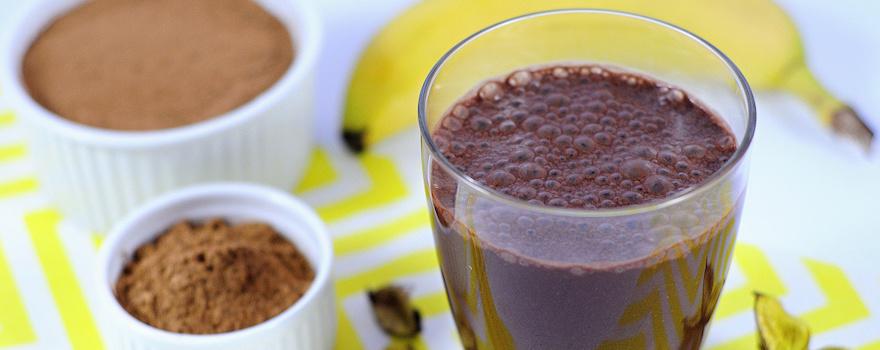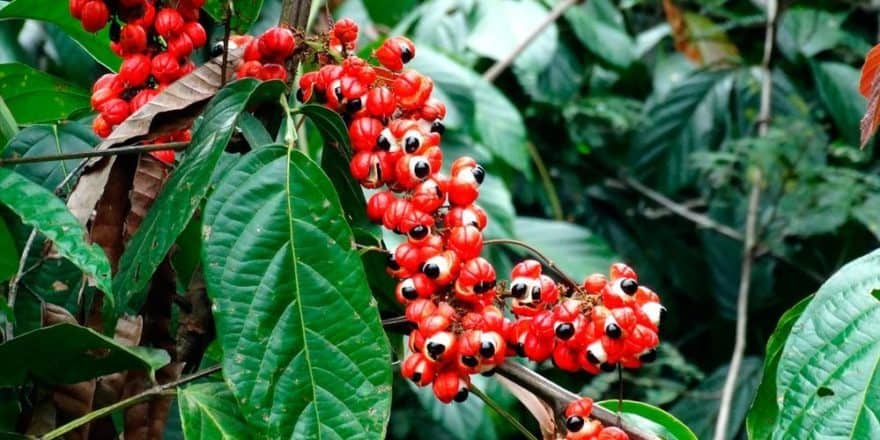BENEFITS OF GUARANA
✓ Stimulant and energizing
✓ Improves concentration
✓ Improves memory
✓ Helps with weight loss
✓ Antioxidant
What is guarana?
Guarana (Paullinia cupana) is a shrub native to the Brazilian Amazon, whose seeds of the same name have been consumed since the pre-Columbian era by various ethnic groups. Belonging to the family Sapindaceae, like lychees and chestnuts, it is usually cultivated in the humid Amazonian forests in Brazil, Paraguay, Peru, Colombia and Venezuela.
It’s a climbing shrub, a bit like a vine. It produces red berries containing a black seed wrapped in white flesh. When the fruit is ripe, the berry bursts and, as the Guarani Indians say, transforms into the “eye of the forest”.
It is this black seed that has been used for centuries by the Guarani and other Amazonian ethnic groups to treat certain illnesses and to increase energy, libido, and endurance of the Amerindians.
Indeed, guarana is a powerful stimulant. It contains up to four times more caffeine than coffee! The caffeine contained in guarana is called guaranine. It’s a marketing term, because it is exactly the same molecule. Its properties were introduced to Europe in the 18th century by the German botanist Christian-François Paullini, who gave it its scientific name.
Guarana can be consumed as a powder, in capsules, or as a beverage. In Brazil, a guarana-based soda, the Guaraná Antartica, is the best-selling beverage after Coca-Cola!

Nutritional composition
- Caféine (ou guaranine)
- Antioxydants : tanins, catéchines, théobromine
- Polysaccharides
- Protéines
- Vitamines A, E, B1, B3
- Minéraux : calcium, potassium, phosphore, fer, zinc, cuivre, magnésium
- Acides gras essentiels
Benefits of guarana
The guarana seed is a concentrate of active compounds, including caffeine, responsible for its many benefits. The advantage of this superfood compared to others is that its effects have been widely studied and are mostly scientifically proven. Here are the main virtues of guarana.
⚡️ Stimulating and energizing
Guarana is a powerful natural stimulant and energizer. The high level of caffeine it contains will stimulate the central nervous system and trigger the release of adrenaline. The advantage is that, thanks to tannins, guarana does not cause the side effects of coffee (restlessness, palpitations, insomnia…).
It enhances reflexes and helps fight drowsiness. It increases our resistance to fatigue and gives us energy throughout the day. Indeed, the tannins it contains allow for slow absorption, which helps preserve its effects over the long term and support sustained effort.
It is particularly recommended during sports practice since it increases strength, endurance, and recovery after exertion. It prevents the accumulation of lactic acid in the muscles, thereby reducing muscle soreness.
This study from Northumbria University in Newcastle showed that a dietary supplement composed of vitamins, minerals and guarana reduced mental fatigue. This one, conducted by the Federal University of Paraíba in Brazil on mice, showed that guarana increased physical strength.
👩🏫 Improves concentration and memory
Guarana increases cognitive performance, notably concentration, memory and learning ability, thanks to caffeine but also other alkaloid substances present in guarana that are still under study. A course of guarana can be a real asset for students during exam periods, for example.
It is often recommended to combine it with ginseng to further boost these abilities.
This study from Northumbria University in Newcastle showed that guarana contributed to better learning and improved intellectual performance. Furthermore, this study by the Federal University of Santa Maria in Brazil conducted on rats demonstrates that guarana increases memory.
🏃♂️ Helps with weight loss
Guarana is a fat burner, it is often used in the diet product industry aimed at weight loss and combating obesity. It is particularly recommended during a diet, as it also helps maintain an optimal energy level.
It activates our metabolism, which allows you to burn more calories even at rest. It helps eliminate bad fats as well as bad cholesterol, and provides a feeling of fullness.
However, in this respect its action alone is not sufficient; it must be combined with a balanced diet and regular exercise.
This study from the School of Medicine of the University of Sao Francisco in Brazil demonstrated that guarana inhibits the production of fat cells and promotes genes that reduce them. This one, conducted by the Federal University of Santa Maria in Brazil on a sample of an Amazonian population over 60 years old, showed that guarana consumers have a lower average waist circumference than others.
🥝 Antioxidant
Guarana is a rich source of antioxidants, including caffeine, but also tannins, theobromine (like cocoa), the catechin, and saponins. In this respect it is quite similar to green tea, and therefore to matcha.
These antioxidants will fight free radicals, protecting our cells from oxidative stress. They are particularly effective against skin aging.
The catechin, more specifically, will help improve circulation, prevent inflammatory and coronary diseases, and thus protect the heart.
This study from the Federal University of Santa Maria in Brazil, conducted on 42 older adults, demonstrated that guarana and its antioxidants reduce the risks of cardiovascular diseases.
How to consume guarana?

Choose organic guarana
The production of guarana in Brazil is industrial : it has to meet the high demand of agribusiness and the pharmaceutical industry. Many farmers resort to pesticides, hybrid species, and GMOs.
But there are also numerous organic producers certified AB and Écocert, who traditionally cultivate wild strains of guarana. For example, the Satéré Mawé tribe in the state of Amazonas still produces organic and fair-trade guarana, which can be found commercially.
The organic guarana is recommended because it will be better for health (free from pesticides and toxic substances), richer in nutrients and therefore more effective. In addition, organic farming has less impact on the environment, and helps better preserve the threatened territory that is the Amazon.
Guarana powder
Consuming guarana powder is the best way to benefit from all its properties because the seed is minimally processed. Traditionally after harvest, the seeds are removed from the red berries, then they are cleaned, dried in the sun or on iron millstones, roasted and ground. It is formed into a paste rolled into a cylinder which is then grated to obtain guarana powder.
It is also easy to incorporate into our daily diet: diluted in water, in a juice or mixed into a yogurt or a smoothie.
Also read | What you need to know before buying guarana
Guarana powder is often used in cosmetics because its high caffeine content makes it an ally for the skin. It notably helps fight aging and cellulite.
Guarana capsules
Guarana capsules are the most practical form of consumption, as they allow good control over the dosage. One should always check their caffeine content and concentration, and verify that they do not contain synthetic caffeine or additives.
Guarana beverage
Today, many energy drinks (energizing beverages such as Red Bull), smart drinks (nutrient-concentrated energy drinks) and slimming drinks contain guarana. Its stimulating properties and the fact that it is a fat burner make it a major marketing asset.
These drinks actually contain little guarana and a huge amount of additives; they are not recommended as part of a healthy, balanced diet.
If you prefer to consume guarana as a beverage, you might as well prepare it yourself using powder, or steep the seeds.
➜ Everything you need to know about guarana as a beverage

Dosage
Guarana is clearly not recommended in the evening, like coffee, so as not to disturb our sleep. In addition, it is advised not to exceed 5 g if you consume caffeine elsewhere. It is recommended to start with a 4- to 6-week course to regain energy and fight fatigue. Continuous consumption is strongly discouraged because there is a risk of dependence.
Contraindications and side effects
There is no danger in taking guarana as long as the recommended daily doses are respected. Side effects are rare if these doses are followed. Nonetheless, cases of heart palpitations and stomachaches have been reported.
Guarana is not recommended for pregnant or breastfeeding women, for people with high blood pressure, cardiovascular problems, or insomnia.
Guarana can interact with certain medications, so it is advised to seek medical advice in the case of occasional or ongoing treatment.
History and current cultivation
According to a myth of the Sateré-Mawé, indigenous people of the state of Amazonas in Brazil, a malevolent deity once killed a young villager. To comfort the tribe, a benevolent deity first planted his left eye in the forest, which became wild guarana. He then planted his right eye in the village, allowing the domestication and cultivation of guarana.
Guarana was introduced to Europe as early as the Portuguese and Spanish conquest in the 16th century, without success. It was truly industrialized and marketed from the 1960s, when it was introduced to other states of Brazil to meet growing demand. The current production is 4000 tons per year, coming from the states of Amazonas, Mato Grosso and Bahia. Brazil produces 95% of guarana, but it is also found in Venezuela.



